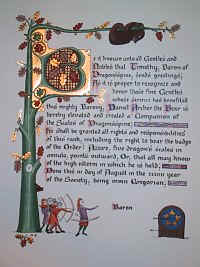
Scales of Dragonsspine
based upon
The Luttrell Psalter
Marko Evanovich Panfilov
Barony of Dragonsspine,
Kingdom of the Outlands
September 28th, A.S. 37 (2002)

 |
Scales of Dragonsspine
|
 |
This scroll is based upon the style of the Luttrell Psalter, a personal prayerbook created in England, early in the 14th century. This famous manuscript is well known for its depictions of rural life in the Middle Ages. The original manuscript is preserved at the British Library. The Luttrell Psalter, 1989, by Janet Backhouse of the British Library, contains many photographs of the original document. The scroll was created in July A.S. 37 (2002) for Baron's War and was my seventh scroll. My first scroll was created in November, A.S. 36 (2001).
Several pages from the Luttrell Psalter were chosen as inspiration for this scroll. The overall design was taken from f. 59 verso, which is dominated by an oak tree in the autumn woods (see image above). The illumination was also designed to reflect the persona of the scroll recipient, Daniel Archer the Bear, who is, in fact, an accomplished archer. The scene of archers along the bottom of the scroll comes from f. 147 verso (see figure 6). His arms, Vert, a bear and a lion combattant and a bordure embattled Or, inspired the color selection and the images of the bears on the scroll.
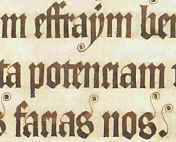  |
The hand used in the Luttrell Psalter is a modified Gothic, with early Versals used for the initial capitals. The flourishes unique to the Luttrell Psalter, such as the letter ‘s’ and the spirals attached to the punctuation, were reproduced in the calligraphy for the scroll. The letters in the original manuscript are somewhat taller and narrower than the hand used on the scroll. |
| Figure 1. Left: Calligraphy from the Luttrell Psalter. Right: Calligraphy from the scroll. | |
  |
Many of the initial Versals in the Luttrell Psalter are surrounded with fine line work, or filigree. This type of embellishment was common in Gothic manuscripts and was usually done in a color complementary to the color of the capital. Important capitals, such as in a person’s name, were often written in red or blue in order to stand out better and reflect the importance of the person. |
| Figure 2. Left: Filigree from the Luttrell Psalter. Right: Filigree from the scroll. | |
The original manuscript was likely
created using cut quills, usually from a goose, dipped in iron gall ink and
written on vellum made from calfskin. Due to the high cost of calfskin vellum,
modern paper was used instead. Acid-free Bristol paper was chosen to preserve the work over time. A metal nib dip
pen was used in place of the quill to avoid the constant sharpening needed by
quill pens. Permanent light-fast black ink was used for archival purposes
instead of the period ink that is brown and turns black as it oxidizes.
Gold leaf was applied to the illuminated capital and several of the oak leaves. Gold leaf became common in the 10th century Romanesque period and was very common in later Gothic manuscripts, although there was only a small amount of gold leaf used in the actual Luttrell Psalter. In period, a gesso made of slaked plaster, sugar, hide glue (or fish glue), and white lead would have been used. In the dry climate of Colorado, such a mixture does not work well, so a modern substitute of acrylic gloss medium (sometimes called Hyplar) was used instead. Blowing gently on the dried acrylic size makes it tacky, and gold leaf is carefully laid over the surface and burnished until shiny.
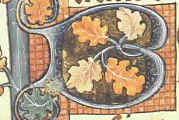
 |
|
| Figure 3. | Left: Initial capital 'B' from the
Luttrell Psalter. Right: The initial capital 'B' on the scroll, using gold leaf. |
In the Middle Ages, many paints were made from very toxic materials. For example, red paint contained lead or iron. Yellow was made from orpiment, which contained arsenic oxide. Verdigris green contained copper and strong vinegar, or malachite. For the scroll, modern gouache was used. Although the actual chemicals are different and safer, gouache still consists of finely powdered pigments mixed with a binding agent such as gum arabic. The colors used on the scroll are representative of the colors found throughout the Luttrell Psalter. Greens and gold were used to match the colors of the recipient's arms, but an autumn palette, as used in the original, was maintained.
The shading, or "white work" on the scroll was done to match the examples in the Luttrell Psalter. A diluted white gouache was applied and blended into the base color using water. Then, a very fine brush was used with a thicker white gouache for the white lines. This shading technique was also used on the line fillers, whose designs were also taken from the original manuscript.
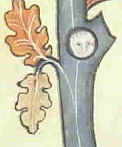  |
|||
| Figure 4. | Left: The oak tree from the
Luttrell Psalter. Right: The oak tree on the scroll. |
Figure 5. | Top: Line filler from the Lutrell Psalter. Bottom: Line filler from the scroll. |
The scene of archers required a bit more complex shading, but the same technique was used. A fine metal "crow quill" pen was used with black ink to create the details in the faces and bows. In the Middle Ages, an actual crow’s quill would have been used due to it’s small size and stiffness, although a real crow’s quill would require a frequent sharpening compared to the metal pen.

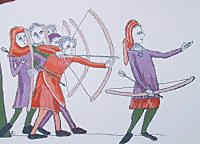 |
|
| Figure 6. | Left: Archers from the
Luttrell Psalter. Right: Archers on the scroll. |
Since this was the first miniature scene I had ever attempted on a scroll, the original image was traced and then transferred to the scroll. That copy was then painted and outlined. The brown bear, hanging from the upper branch of the oak tree, was traced from The Hunting Book, a period hunting treatise by Gaston Phoebus. All other elements in the scroll were created freehand without any tracing.
I'm very pleased with how this scroll turned out. It has given me great respect for the skills and artistic talents of the medieval monks and scholars who painstakingly created the illuminated manuscripts of the Middle Ages. I also enjoyed combining period elements in order to customize the scroll towards the persona of the recipient. In the future, I will continue to concentrate on improving the spacing of the calligraphy and will try producing original miniatures rather than tracing existing illustrations.